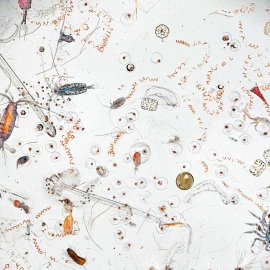Life in a Drop
-
English
-
ListenPause
I’m Peter Neill, Director of the World Ocean Observatory. Recently via social media, the World Ocean Observatory received an astonishing photograph taken of a single drop of ocean water at 25 times magnification revealing the random inventory of life contained therein. The accompanying message lists the major identifiable species; what is so undeniably evident is the simplicity of these entities and the complexity of their metabolism and engagement in the larger process of the ocean as global accumulation of biomass and contribution to the health of the planet. What seems at first so understated and miniscule reveals on further consideration what is so amplified and essential about the ocean’s engagement with human life and survival. It is as if all the vast ocean is there alive in a single drop. What do we see? First, fish eggs are abundant, many types, suspended as potential contribution to the food chain either as immediate feed for other fish or as future feed for larger predators including possibly ourselves. There are also marine worms, very similar in appearance to land worms, multi-segmented polychetes with dozens of tiny hair-like appendages for motivation through the water. There are crab larvae, much more fully developed, a quarter of an inch long, delicate, transparent arthropods with visible internal organs, eight legs, pincered claws, and bug eyes with compound lenses so prominent as the crab matures. And there are Copepods, tiny shrimp-like crustaceans, common zooplankton that are the most basic source of protein for countless fish species. These animals are energetic swimmers with a well-developed nervous system that provides active motility to evade capture. But there is much more, microscopic organisms, in enormous number, like Diatoms, a single-celled type of algae, encased in a silica cell wall, or Chaetognaths, plankton with eyes and teeth and tiny spines that grapple with small plankton for feed, sometimes injecting a paralytic venom, or Cyanobacteria, coiled filaments among the most primitive life forms that use sunlight to produce sugar, that’s correct, you remember, photosynthesis, liberating oxygen into the atmosphere for us to breathe. Diatoms, Chaetognaths, Cyanobacteria – these are little guys with big ideas, part of a bigger system with even bigger consequences for us all. Relevant. Necessary. Vulnerable. But there is another aspect of the image that is equally impressive – its fantastic beauty, as if a collaboration between artist and scientist, whimsical abstraction mixed with observed illustration, Paul Klee and Charles Darwin, working on a canvas as big as life. And again, forgive me, another visual association also comes to mind-- those maps of the night sky wherein fish eggs are scattered like stars, worms like planets, larvae like constellations, plankton flowing like a milky way, copepods like shooting asteroids, bacteria like the astral light of distant galaxies, there but almost invisible to the eye. What do we feel when we confront the cosmos? What do we feel when we confront the ocean? Surely, we are humbled, made to feel, yes, almost microscopic in the vast fluidity of space and the sea. Surely, we are moved, by the beauty of it all, its inherent sense of time and space. Surely, we are awed by the infinite scale and apparency of dynamic change. Surely, we are restored by the truth of what we feel, an empathetic understanding of the value of this world we live in and of the obligation we have not to destroy it, poison it, deprive it of the many manifestations of vitality it all its forms. Surely, when faced with such a view, whether through a telescope, a microscope, or the naked eye, we know what we must do to enable life as we see it, in health and wellness of friends, family, community, nations, our world, indeed life in every drop. There is so much work to do. We will discuss these issues, and more, in future editions of World Ocean Radio.
What do we see in a single drop of ocean water? An image captured by David Liittschwager for National Geographic, then magnified 25 times, reveals an impressive abundance of many types of microscopic organisms. In this episode of World Ocean Radio, host Peter Neill will describe some of the creatures discovered therein, and will discuss the larger systems at work in the vast cosmos of a single drop of water.
Image: A single drop of seawater, magnified 25 times, teems with life.
Credit: David Liittschwager | National Geographic
________________________________________________________________________
Peter Neill, host of World Ocean Radio, provides coverage of a broad spectrum of ocean issues from science and education to advocacy and exemplary projects. World Ocean Radio, a project of the World Ocean Observatory, is a weekly series of brief audio essays available for syndicated use at no cost by community radio stations worldwide. Contact us for more information.
- Login to post comments



